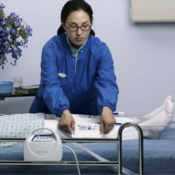This handout explains intubation and describes items that are used during that process. Intubating a patient occurs when the patient needs help breathing. This information can help you prepare for, and understand, what you might see when a patient is intubated and on a ventilator.
What is an endotracheal tube (ET)?

An endotracheal (ET) tube helps the patient breathe. The tube is placed into the mouth or nose, and then into the trachea (wind pipe).
The process of placing an ET tube is called intubating a patient.
The ET tube passes through the vocal cords, so the patient won’t be able to talk until the tube is removed. While the tube is placed, nursing staff will help find other ways for the patient to communicate.
What is a ventilator?

The ET tube is attached to a ventilator. This machine helps the patient breathe and keep enough oxygen in the blood.
How do you keep my child comfortable?
While using a ventilator, it’s important that the patient be comfortable and allow the ventilator to do some of the work of breathing. To help keep the patient comfortable, we use medicines to help treat pain and promote sleep.
What are nasogastric or orogastric tubes?
A nasogastric or orogastric tube is a small, flexible tube that is placed into the nose (nasogastric) or mouth (orogastric), and extends into the stomach. It might be attached to a suction canister on a wall near the patient’s bed to remove stomach contents, which can help prevent nausea or vomiting. Nasogastric and orogastric tubes can also be used to provide nutrition. This is called tube feeding. These tubes can also be used to deliver medications.
Why are soft restraints used?

When patients are using a ventilator, it’s important to keep them safe. Restraints are soft cloth devices that prevent a patient from accidentally pulling out tubes or IV lines. Some restraints are wrapped around the wrists. Others cover the elbows, preventing the patient from bending the arms.
While restraints are on, staff will closely watch the patient.
What is a sequential compression device?

While intubated, patients don’t move as they normally would, which increases their risk of developing blood clots. Using a sequential compression device helps prevent this. The device includes a pump and an attached sleeve. The patient wears the sleeve around the leg, and the device helps move blood from the legs to the heart. Using a sequential compression device is a very important way to help a patient recover.
What are some safety precautions?
While a patient is intubated, we take many precautions to help prevent ventilator-associated pneumonia (VAP), a lung infection that can occur when someone uses a ventilator.
The care we provide to help prevent VAP includes:
- Elevating the head of the patient’s bed
- Suctioning and cleaning the patient’s mouth
- Allowing the patient to wake up while on the ventilator to check if the patient can breathe without the ventilator support
While a patient is intubated, we take many precautions to help prevent ventilator-associated pneumonia (VAP), a lung infection that can occur when someone uses a ventilator.
Care we provide to help prevent VAP includes:
- Elevating the head of the patient’s bed
- Suctioning and cleaning the patient’s mouth
- Allowing the patient to wake up while on the ventilator to check if the patient can breathe without the ventilator suppo
How can I help my child?
There are ways you and other caregivers can help when a patient is intubated.
- Wash your hands before you enter the patient’s room and when you exit.
- If you notice a staff member not washing hands before entering the room, it’s OK to mention it to that person or another staff member.
- Avoid touching the ventilator and all equipment connected to it. This helps ensure settings programmed especially for the patient aren’t disrupted.
- Feel free to ask physicians when sedation will be turned down or off, and when the breathing tube will be removed.
This information is for educational purposes only. It is not intended to replace the advice of your health care providers. If you have any questions, talk with your doctor or others on your health care team.
If you are a Gillette patient with urgent questions or concerns, please contact Telehealth Nursing at 651-229-3890.
 Home Page
Home Page
